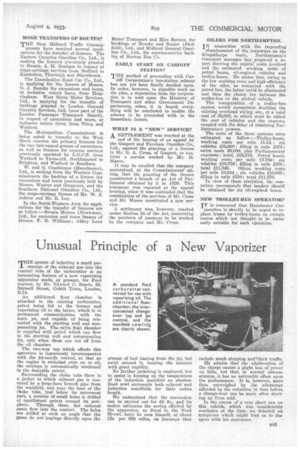Unusual Principle of a New Vaporizer
Page 51

If you've noticed an error in this article please click here to report it so we can fix it.
T'
system of injecting a small per centage of the exhaust gas into the venturi tube of the carburetter is an interesting feature of a new vaporizing apparatus made, at present, for Ford engines, by Mr. Edward C. Seeds, 39, Seyssell Street, Cubitt Town, London, E.14.
An additional float chamber is attached to the existing carburetter, petrol being fed to the former and vaporizing oil to the latter, which is in permanent communication with the main jet, and capable of being connected with the starting well and compensating jet. The extra float chamber is supplied with petrol which can flow to the starting well and compensating jet, only when these are cut off from the oil chamber.
The two-way tap which effects this operatimk is ingeniously interconnected with the jet-needle control, so that as the engine is switched over on to oil, the mixture is automatically weakened to the desirable extent.
Surrounding the choke tube there is a jacket to which exhaust gas is conveyed by a large-bore branch pipe from the manifold, and near the base of the choke tube, just below its narrowest part, a number of small holes is drilled at equidistant points around its periphery. Through these, hot exhaust gases flow into the venturi. The holes are drilled at such an angle that the gases do not impinge directly upon the stream of fuel issuing from the jet, but swirl around it, heating the mixture with great rapidity.
No further jacketing is employed, but to assist in keeping up the temperature of the induction manifold an abestoslined cowl surrounds both exheust -and induction manifolds for their entire length.
We understand that the conversion can be carried out for £8 8s., and its maker estimates the saving effected by the apparatus, as fitted to the Ford 30-cwt. lorry he uses himself, at about 15s. per 500 miles, on journeys that
include much stopping and thick traffic.
He admits that the adulteration of the charge causes a slight loss of power on hills, but that, in normal circumstances, it has no noticeable effect upon the performance. It is, however, more than outweighed by he advantage afforded by the reduction in time before a change-over can be made after starting up from cold.
In the course of a very short run on this vehicle, which was considerably overladen at the time, we detected no symptoms which might lead us to di agree with his statement.




















































































